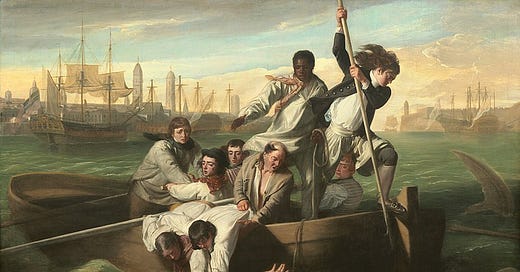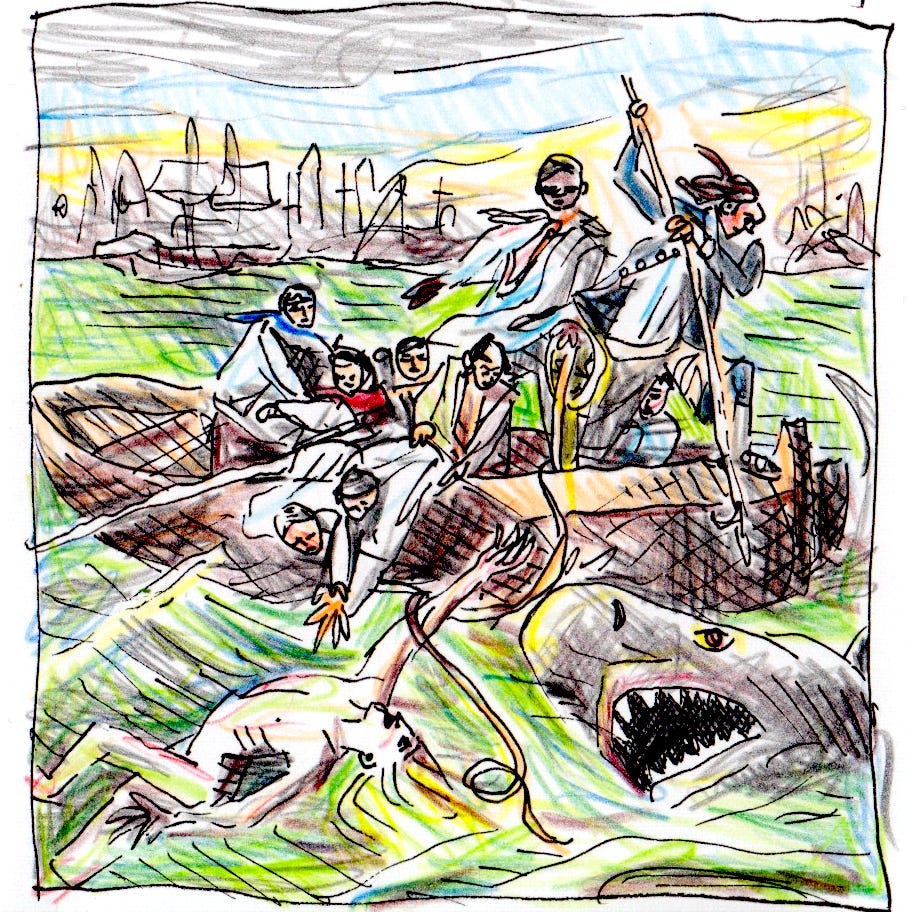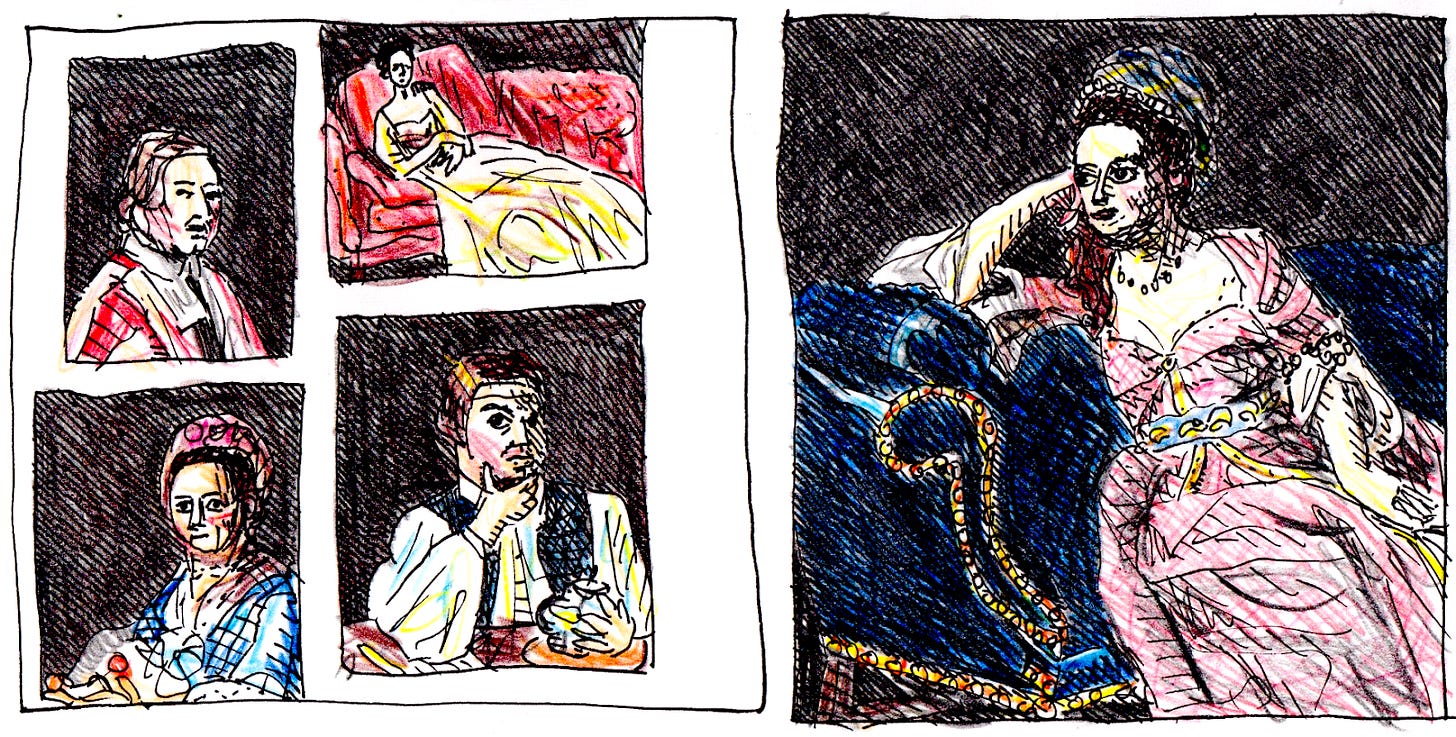Edith Zimmerman is a writer and artist. She publishes the newsletter Drawing Links and illustrates the sobriety/recovery newsletter The Small Bow. In the past she ran The Hairpin, and her last WITI contribution was on knitting with sea silk.
Edith here. About a week ago, an Instagram account I follow shared an old painting: “Watson and the Shark,” by John Singleton Copley, from 1778.
The painting depicts a naked youth floundering in the ocean while a huge shark approaches to bite him. Nearby, several men attempt a rescue, but it seems a little dicey. The boy looks back at the animal, wild-eyed. What happens next??
I was riveted by the painting and later sketched my own version. I also did some googling—and the picture is totally famous, so apologies to everyone who’s already in the know—but I loved its backstory and wanted to share.
Edith’s version
The scene was based on a real event: in 1749, in the waters off Havana, Cuba, a 14-year-old cabin boy decided to go for a dip in the ocean while his ship was in port. As he swam, a shark bit his leg and dragged him under. The shark released him but then bit again, this time severing the boy’s foot. Nearby sailors—horrified—came to his rescue in a skiff, reportedly just before the shark’s third strike. (At “the very instant he was about to be seized the third time,” per a description of the painting published when it was first exhibited, “the shark was struck with the boat hook, and driven from his prey.”) The boy’s leg was later amputated from the knee down, but he otherwise recovered fully and went on to have a long and successful career in business and politics. His name was Brook Watson.
Twenty-five years or so later, Watson apparently got in touch with the painter John Singleton Copley to commission a picture about the encounter. What resulted was “Watson and the Shark.” (There’s much more story here—the painting was unusual for its time and basically helped earn Copley admission into the Royal Academy of Arts—but I’m skipping that for the sake of brevity.) By all accounts, Watson loved the picture, and in his will he bequeathed it to Christ’s Hospital, a charity school in England, saying he hoped they would “allow it to be hung up in the Hall … as holding out a most useful Lesson to Youth.” (The lesson presumably being: never go for a swim! Just kidding: actual insight can be found at Artstor, although the ultimate moral isn’t totally clear.) The school later sold the painting to Washington DC’s National Gallery of Art, where it currently hangs.
I ended up scrolling through Copley’s earlier portraits, too, and was similarly blown away. Something about the subjects seemed so real to me, as if they’d existed just yesterday. (For instance: her, him, her, him, and her.) Also, a cute guy in one picture who looked like a saucy bartender turned out to be… Paul Revere.
In any case, be careful in those waters! (EZ)
My renditions of some Copley portraits. Definitely go check out the originals!
Quick Links:
“Watson and the Shark,” by John Singleton Copley [Wikipedia] (EZ)
The National Gallery’s American Paintings of the Eighteenth Century, a PDF (EZ)
“Cape Cod’s Waters Are Getting Very, Very Sharky” [The Atlantic] (EZ)
“Don’t Call Them ‘Shark Attacks,’ Scientists Say” [NYT] (EZ)
“Three Ways to Survive a Shark [Encounter]” [WikiHow] Possibly the most stressful WikiHow I’ve ever read. (EZ)
[Sponsored Link] Noah here. Another shout out for my company, Variance. We are building a PLG CRM to help software companies grow their customers. There’s a new post up on the blog about the various organizational antipatterns we see around customer data. Get in touch if you have questions or want to learn more. (NRB)
Thanks for reading,
Noah (NRB) & Colin (CJN) & Edith (EZ)
—
Why is this interesting? is a daily email from Noah Brier & Colin Nagy (and friends!) about interesting things. If you’ve enjoyed this edition, please consider forwarding it to a friend. If you’re reading it for the first time, consider subscribing (it’s free!).





